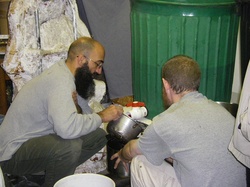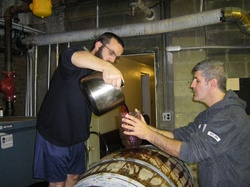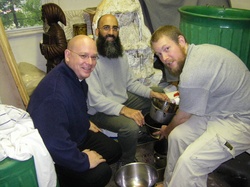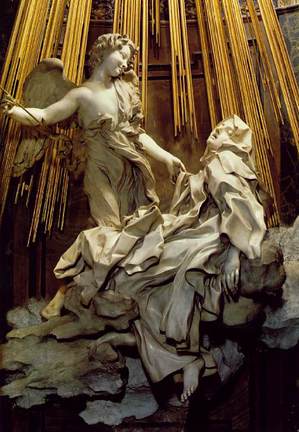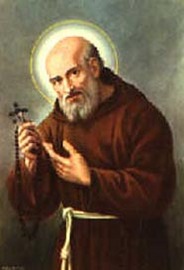 Last night the 64th annual Alfred E. Smith Foundation dinner was held at NY’s Waldorf-Astoria Hotel. It is a fundraising dinner (with the pretty people in attendance). Monies donated at this dinner support a variety of NY charities concerning medical care for the poor, children and under served. The beneficiaries are all very worthy works of charity (mercy).
Last night the 64th annual Alfred E. Smith Foundation dinner was held at NY’s Waldorf-Astoria Hotel. It is a fundraising dinner (with the pretty people in attendance). Monies donated at this dinner support a variety of NY charities concerning medical care for the poor, children and under served. The beneficiaries are all very worthy works of charity (mercy).
Month: October 2009
31 years since John Paul II’s election
Saint Margaret Mary Alacoque
 So I ask you not to lose heart over what I am suffering for you, which is your glory. Lord, pour out on us the riches of the Spirit which you bestowed on Saint Margaret Mary. May we come to know the love of Christ, which surpasses all human understanding, and be filled with the fullness of God.
So I ask you not to lose heart over what I am suffering for you, which is your glory. Lord, pour out on us the riches of the Spirit which you bestowed on Saint Margaret Mary. May we come to know the love of Christ, which surpasses all human understanding, and be filled with the fullness of God.
Consider knowing more about the message of Saint Margaret Mary, which forms some of our devotional life today. This is especially true when it comes to First Friday devotions and to the Sacred Heart of Jesus, source of all love and mercy.
Saint Margaret Mary, pray for us.
Friars of the Renewal keep tradition of wine making
Where else would a seminarian and a priest be doing on a rainy, Thursday afternoon in
the middle of prep work for midterm exams & papers? If you guessed wine
making then you answered correctly. Taking a break from an afternoon of
meetings, paper writing and exam prep, Father Philip (from Burma) and I took a
ride over to Saint Leopold Friary to see what the good Franciscan Friars of the
Renewal are doing with their wine making project. Brother Giuseppe Maria is
spear-heading a Franciscan making effort for two years. This second try seems
to be off and running well.
Sacred Scripture supports wine drinking (and wine making, of course). Can one ever think of true Christianity without wine? If you
don’t believe me look at 1 Timothy 5:23 which says: “No longer drink only
water, but use a little wine for the sake of your stomach and your frequent
ailments.” If you want more holy Scripture, try on Revelation 6:5-6 for size:
When he opened the third seal, I heard the third living creature say, “Come!”
And I looked, and behold, a black horse! And its rider had a pair of scales in
his hand. And I heard what seemed to be a voice in the midst of the four living
creatures, saying, “A quart of wheat for a denarius, and three quarts of barley
for a denarius, and do not harm the oil and wine!”
Looking into the spiritual
tradition you can see monks and friars making wine and beer for medicinal
purposes. Let’s just look a the Benedictine tradition for a second. In chapter
40 of his Rule for Monasteries, Saint Benedict doesn’t think wine should be
served to monks but he concedes that it may be served to the
sick and those who
can’t be persuaded otherwise. Saint Benedict writes: “However, with due regard
for the infirmities of the sick, we believe that a half a bottle of wine a day
is sufficient for each. And then he says: “We read it that monks should not
drink wine at all, but since the monks of our day cannot be convinced of this, let
us at least agree to drink moderately and not to the point of excess, for
“wine makes even the wise fall away” (Eccles. 19:2). OK, so tradition
is a beautiful thing and so let’s enjoy a little bit of life. Just for the
record, Mount Angel Abbey has a Festival of Arts and Wine.
So it is no wonder Brother Giuseppe and his Franciscan brothers are making
wine. This IS serious work!
Here are some photos of step two in making homemade wine.
Our Lady of
Cana, pray for us.
Saint Teresa of Jesus (Avila)
Come, Spouse of Christ, receive the crown which the Lord has
prepared for you for all eternity.
Graciously hear us, O God our Savior, that
as we rejoice in the festival of blessed Teresa, Your Virgin, so may we be fed
by her heavenly teaching and be strengthened in the love of true piety.
This is image of Saint Teresa was done by Bernini and it brings together notable themes of his life and work. Namely, the meeting of heaven and earth; God bowing down to touch the heart of man and woman. Bernini’s influence on doing this sculpture was this passage from Saint Teresa’s autobiography:
“I saw
in his hand a long spear of gold, and at the iron’s point there seemed to be a
little fire. He appeared to me to be thrusting it at times into my heart, and
to pierce my very entrails; when he drew it out, he seemed to draw them out
also, and to leave me all on fire with a great love of God. The pain was so
great, that it made me moan; and yet so surpassing was the sweetness of this
excessive pain, that I could not wish to be rid of it. The soul is satisfied
now with nothing less than God. The pain is not bodily, but spiritual; though
the body has its share in it. It is a caressing of love so sweet which now
takes place between the soul and God, that I pray God of His goodness to make
him experience it who may think that I am lying.” (The Life of Teresa of Jesus, Chapter 29, part 13)
Recall that this saint’s life spanned from 1515-1582 and she was a contemporary with Saint John of the Cross, Saint Ignatius of Loyola and Saint Peter of Alcantara (who encouraged the Carmelite reform) was a spiritual father to her. She is also 1 of 3 women Doctors of the Church. If what you read here appetizing to read more of Saint Teresa’s life and work, I would recommend starting with the brief bio at New Advent, the Interior Castle and then or The Collected Works of St. Teresa of Avila.
How tall are your doctrinal walls?
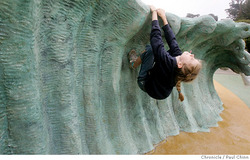 G. K. Chesterton once wrote, “Catholic doctrine
G. K. Chesterton once wrote, “Catholic doctrine
and discipline may be walls; but they are the walls of a playground. We might
fancy some children playing on the flat grassy top of some tall island in the
sea. So long as there was a wall round the cliff’s edge they could fling
themselves into every frantic game and make the place the noisiest of
nurseries. But the walls were knocked down, leaving the naked peril of the
precipice. They did not fall over; but when their friends returned to them they
were all huddled in terror in the centre of the island; and their song had
ceased.” Orthodoxy Ch. 9
Saint John Ogilvie
 O God, You revealed the power of the Spirit in Your holy martyr John. Through his example and prayers, strengthen us to serve the Church under the banner of the cross and to carry out in every land the missions entrusted to us by the successor of Peter.
O God, You revealed the power of the Spirit in Your holy martyr John. Through his example and prayers, strengthen us to serve the Church under the banner of the cross and to carry out in every land the missions entrusted to us by the successor of Peter.
Saint Seraphin of Montegranaro
Catholic education: where is it going and why?
The Catholic school system in the US has been in a very desperate shape for years: acute and chronic money problems, lack of good, solidly trained Catholic teachers and administrators, a coherent vision of Catholic education as it interfaces with the charism of the religious order/diocese operating the school, building & grounds in near of repair, low endowments, etc. Then there is the assessment of what is purported to constitute a Catholic school: poor formation in the faith, the arts & humanites and science suffer, good use of current technologies, and engagement with people who do things differently, engagement with the vulnerable and culture of life, etc. Many, many Catholic schools don’t offer the Sacrifice of the Mass on a weekly basis for the students; and very few of them that I am familiar with offer reliable guidance and formation of the faculty and parents. In my book, if the bishop rarely shows up and the pastor visits the school only when there is crisis. then the problem is more acute.
Don’t get me wrong: I am a product of a lot years Catholic education and wouldn’t trade it for anything. I love my time in the Catholic schools I attended but I can see the gaping holes in education and experience. I also believe that the Church needs excellent schools and formation programs.
Five exceptions to this critical view may be the five schools in the Diocese of Bridgeport recently named “Blue Ribbon” by the US Dept of Ed. But for these success stories in Catholic Education there are thousands of others pointing to major problems.
Today, there is an article in Time that speaks to a corrective of what is noted above. The dynamic Mr. Ekicsen is asking the right questions and seeking reasonable solutions. The bishop of Patterson made an excellent choice in hiring Eriksen and I pray his project thrives. It will –the saints are behind him. Read about the Eriksen initiative…
I think of a few things that are contributing to a renewal of Catholic eduation in the US: 1) Luigi Giussani’s The Risk of Education; 2) the Ed Conference; 3) UND’s ACE program; and 4) Dwight Longenecker’s booklet The Risk of Faith; 5) Catechesis of the Good Shepherd. This is not an exhaustive list by any stretch of reality because I know there are plenty of more good programs/schools out there so please forward the names to me.
Saint Wilfrid
The 7th century Benedictine saint, Wilfrid, who was abbot of his community, elected of bishop of York and who was a wildly talented man and influential is commemorated today. While relatively unknown in this part of the world, he is well-known in England because his tireless zeal for God’s Kingdom. He is credited for acquiring land, building monasteries and churches, patronage of secular and sacred art, and for moving the Church in England from an independent Church to one more obedient to the authority of Rome. The veneration of Wilfrid ought not to be forgotten. Today, let us pray for the Church in England, including the bishops and Benedictines there. Regarding the Benedictines, I am particularly thinking of the monks of Ampleforth, Douai, and Downside Abbeys and the nuns at Stanbrook and Tyburn.

